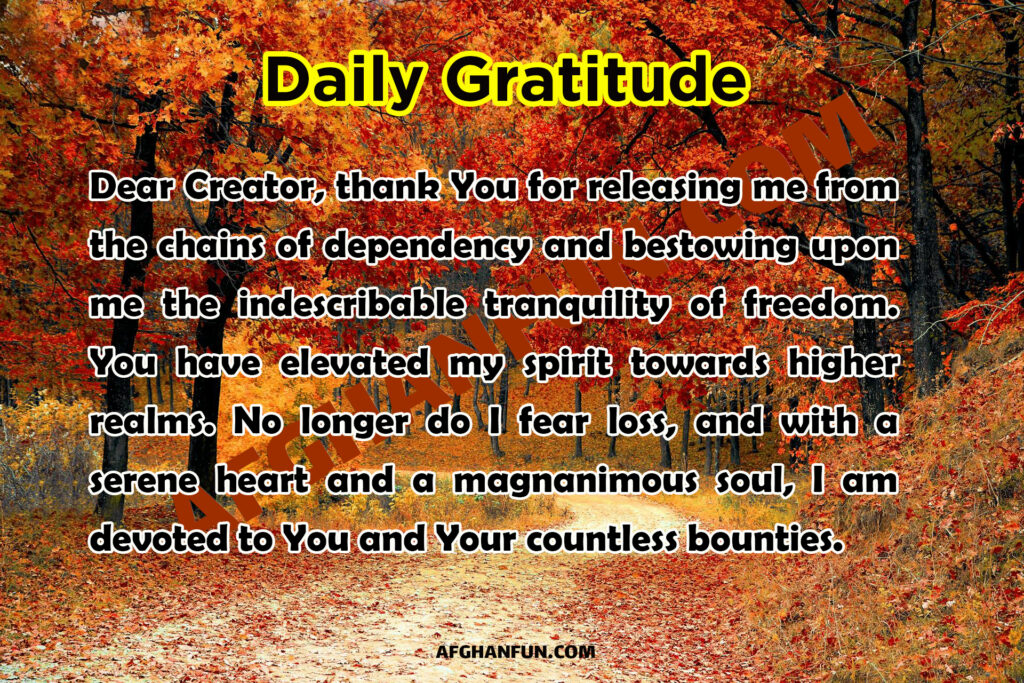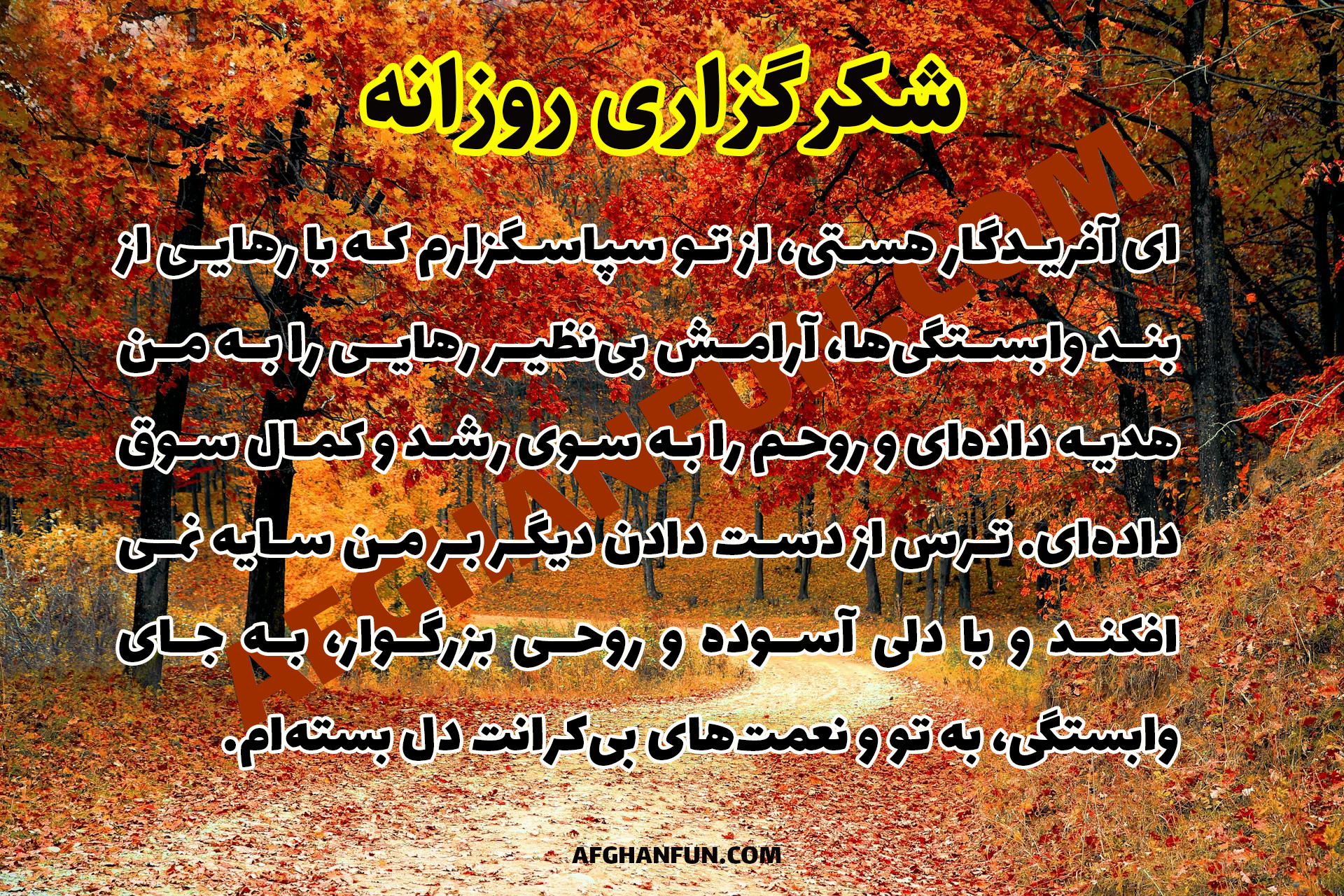
“Dear Creator, thank You for releasing me from the chains of dependency and bestowing upon me the indescribable tranquility of freedom. You have elevated my spirit towards higher realms. No longer do I fear loss, and with a serene heart and a magnanimous soul, I am devoted to You and Your countless bounties.”
ای آفریدگار هستی، از تو سپاسگزارم که با رهایی از بند وابستگیها، آرامش بینظیر رهایی را به من هدیه دادهای و روحم را به سوی رشد و کمال سوق دادهای. ترس از دست دادن دیگر بر من سایه نمیافکند و با دلی آسوده و روحی بزرگوار، به جای وابستگی، به تو و نعمتهای بیکرانت دل بستهام.
Эй Офаринандаи олам, ман ташаккур мекунам, ки бо раҳоӣ аз заҳмати пайвандиҳо, оромии беназири раҳоиро ба ман ҳадя намудӣ ва рӯҳамро ба сӯи рушд ва камол роҳнамоӣ намудӣ. Ҳарос аз даст додан дигар болои ман соя намеандозад ва бо диле ором ва рӯҳи бузург, ба ҷои пайвандиҳо, ба ту ва неъматҳои бекамонат дили худро бастаам
يا خالق الكون، أشكرك على أنك منحتني راحة لا مثيل لها من خلال التحرر من قيود التعلق، وسرت روحي نحو النمو والكمال. لم يعد الخوف من الفقدان يظلل عليّ، ومع قلب مطمئن وروح سامية، بدلًا من التعلق، قد أغلقت قلبي عليك وعلى نعمك اللامتناهية.
This gratitude is a beautifully written expression of appreciation and spiritual connection. Let’s break it down and analyze it from various angles:
1. Tone and Structure:
- Tone: The tone is reverent, heartfelt, and deeply spiritual. The use of phrases like “Dear Creator” and “bestowing upon me the indescribable tranquility” conveys a sense of deep gratitude and awe. The overall sentiment is one of humility and reverence toward the Creator.
- Structure: The text is composed in two main parts:
- The first part focuses on liberation from dependency and the gift of tranquility.
- The second part expresses the transformation of the speaker’s heart and soul, highlighting their newfound peace and devotion.
2. Themes:
- Liberation and Freedom: The first theme is the speaker’s liberation from dependency. This may symbolize freedom from material attachment, emotional reliance, or psychological burdens. The word “chains” suggests that dependency is something that constrains the individual, and “releasing” indicates an active, positive act of divine intervention or blessing.
- Tranquility and Peace: The phrase “indescribable tranquility of freedom” emphasizes the profound peace that the speaker has received, which cannot be easily put into words. This tranquility is a central gift, a result of the freedom from dependency.
- Spiritual Elevation: The text speaks about the elevation of the spirit “towards higher realms,” which suggests a journey or transformation towards a more enlightened or divine state of being. It implies a shift toward spiritual growth and development.
- Fearlessness: “No longer do I fear loss” indicates a major psychological or emotional transformation. The speaker is no longer burdened by the fear of impermanence, which can often be a source of anxiety in human life. This suggests a deepening of trust in the Creator’s plan and providence.
- Serenity and Magnanimity: The speaker describes their heart as “serene” and their soul as “magnanimous.” These qualities suggest inner peace and emotional strength. “Magnanimous” is an important term here, as it implies a generous, noble, and unselfish nature, further underlining the speaker’s personal growth.
- Devotion and Gratitude: The final part of the text expresses a commitment to the Creator and a deep appreciation for the “countless bounties” received. The speaker’s devotion is not based on mere gratitude but is an active, ongoing dedication to the Creator and an acknowledgment of the abundant blessings in life.
3. Imagery and Symbolism:
- Chains of Dependency: Chains symbolize restriction and suffering. By saying the Creator has “released” them, it conveys a sense of freedom and release from what might have previously bound or limited the speaker.
- Indescribable Tranquility: Tranquility is often associated with calmness, peace of mind, and emotional stability. The use of the word “indescribable” suggests that the peace the speaker feels is beyond ordinary experience, almost divine in nature.
- Higher Realms: This can be interpreted as a metaphor for spiritual enlightenment or ascension to a higher state of consciousness or awareness.
- Serene Heart and Magnanimous Soul: These words describe the emotional and spiritual transformation of the speaker. “Serene” conveys calmness and peace, while “magnanimous” implies generosity and an open, expansive heart and soul, willing to embrace all experiences.
4. Philosophical and Spiritual Underpinnings:
- The text reflects a spiritual awakening or self-realization. It portrays the journey from being trapped in the chains of dependency (which could be understood in various ways—attachment to people, material things, ego, or negative emotions) to achieving a state of inner peace, fearlessness, and divine connection.
- The shift from attachment to detachment is central to many spiritual teachings, especially in Eastern philosophies like Buddhism and Hinduism, as well as in mystical branches of Western religions. The speaker expresses gratitude for being freed from the mental and emotional constraints that come with attachment.
- The notion of devotion and surrender in the final sentence shows an acceptance of the Creator’s will and a trust that all bounties are a result of divine grace. This aligns with themes in both Christian and Islamic mysticism, as well as other religious traditions, where surrender to the divine and acceptance of blessings lead to a state of peace and spiritual fulfillment.
5. Psychological Insights:
- The speaker’s emotional state shows a significant transformation from fear and dependency to peace and trust. The transition from fear of loss to fearlessness is a critical shift that many people experience through personal growth or spiritual awakening.
- The presence of a serene heart and a magnanimous soul suggests a mature emotional state. The speaker has likely transcended the ego-driven desires and fears, embracing a more expansive, selfless way of being.
- Devotion and gratitude often act as mechanisms for psychological healing, fostering positive emotions and reducing stress and anxiety. By focusing on divine blessings and expressing gratitude, the speaker cultivates a sense of peace and connection.
6. Overall Message:
The text communicates a profound transformation from a state of dependency and fear to one of liberation, inner peace, and spiritual devotion. The speaker expresses deep gratitude for the Creator’s role in this process of personal and spiritual growth. It is a prayer or affirmation that emphasizes the importance of letting go of attachments, trusting in divine guidance, and being grateful for the blessings received.
In summary, this gratitude text beautifully captures the essence of spiritual growth and liberation, illustrating the shift from fear to fearlessness, from attachment to freedom, and from anxiety to peace. It expresses a profound sense of gratitude and devotion, grounded in a deeper understanding of the divine and the self.











